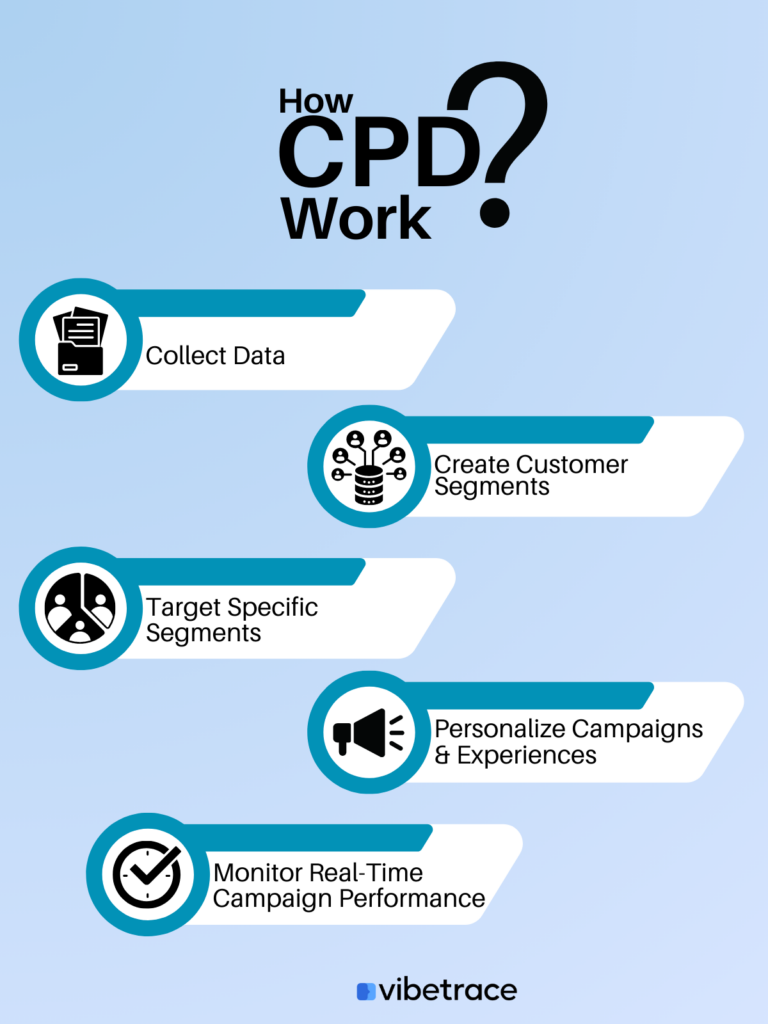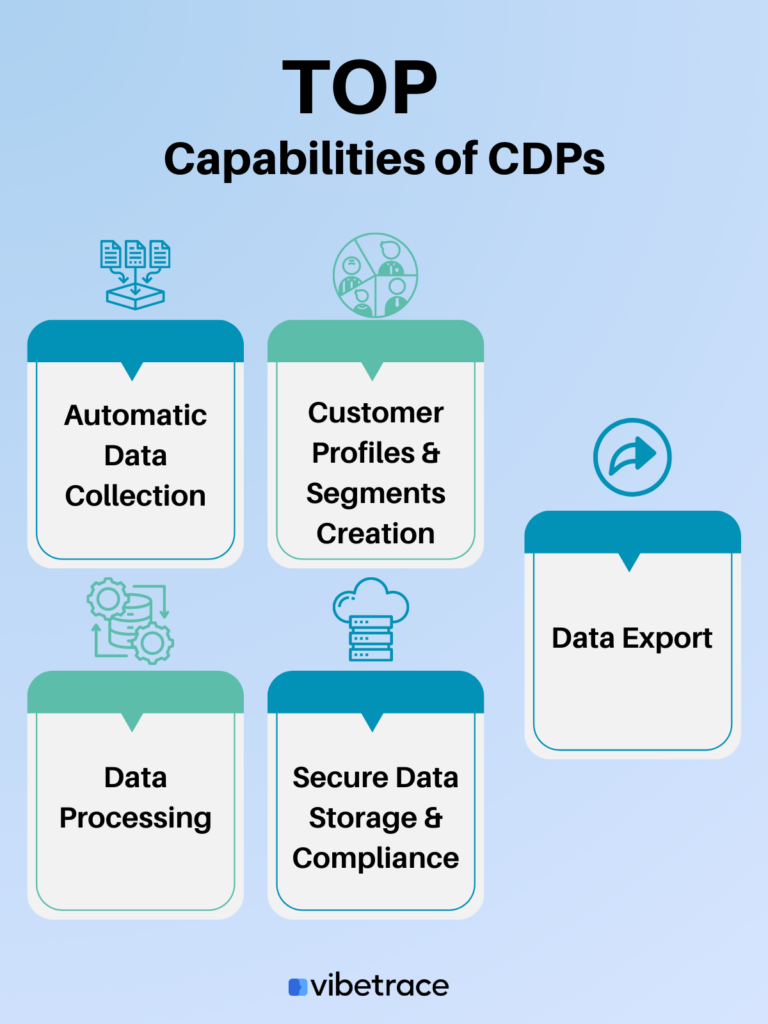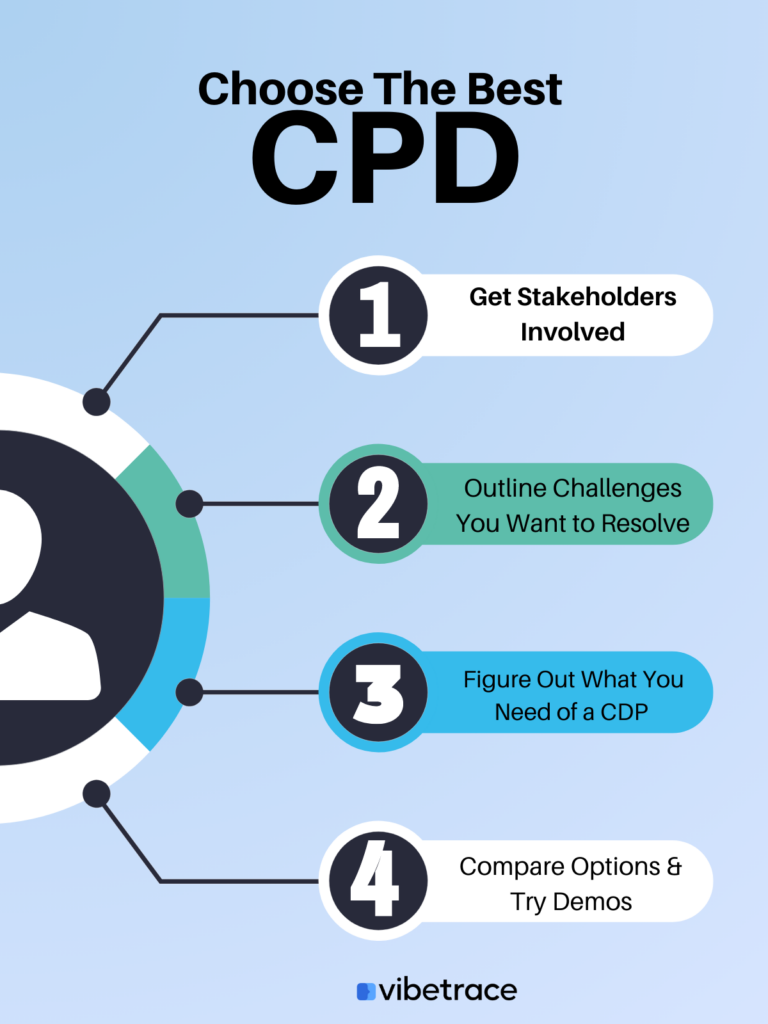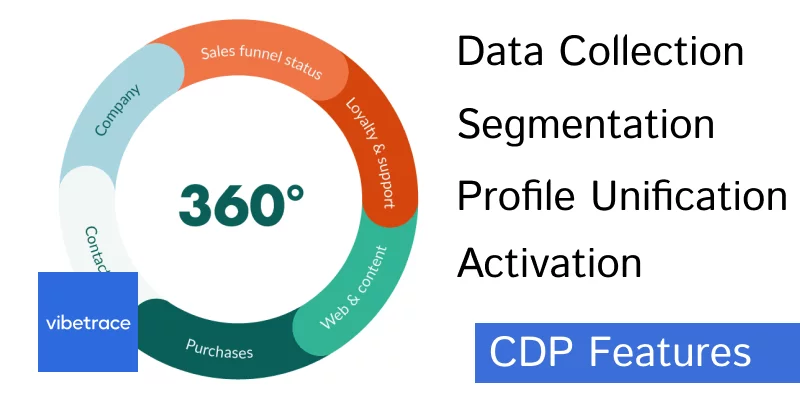Customer Data Platforms have become essential for companies that wish to make the most out of the data they gather. That’s because efficient marketing today is data-driven marketing.
It’s of the utmost importance to use CDPs today if you wish to stay ahead of the competition and changes regarding regulations and data privacy. When using robust marketing platforms like VibeTrace, you get built-in customer data platforms that help you tear down data silos.
That’s the only way you can get a 360-degree view of your customers – gathering information on all interactions across all touchpoints. To help you better understand how CDPs work, below you can find an overview of the processes carried out by them.
In today’s article, we’ll also discuss what features make CDPs an invaluable instrument and how to choose the best option that fits your business needs. Let’s start!
How Does a CDP Work?

Customer data platforms are a crucial element of marketing processes in today’s marketing environment. As part of them, CDPs help you:
- Collect Data – CPDs gather real-time customer data from online and offline sources to help you identify your customers, create detailed profiles, and monitor overall customer behavior and activity;
- Create Customer Segments – you can use the aggregated data to create customer segments based on different segmentation models. Data helps you segment your customer base in a meaningful way to boost results and improve your relationship with your customers.
- Target Specific Segments – when you create customer segments based on CDP-gathered data, you can assign different tags, events, and attributes to each segment. That way, you can launch targeted campaigns created for specific segments and made to achieve individual goals (conversions, engagement, nurturing, etc.)
- Personalize Campaigns & Experiences – CDPs gather information from independent sources, and aggregate it, breaking down data silos. When you closely know your customers, you can create personalized campaigns and experience through specific offers and recommendations. You can tailor your offers to answer the specific needs of individual customers in the segments you made and delight your target audience.
- Monitor Real-Time Campaign Performance – CDPs provide real-time reports on campaign performance and customer interactions. That allows you to adjust your campaigns and optimize them in real time, securing better results for every touchpoint and across all stages of the customer journey.
As you see, customer data platforms play a vital role in modern-day marketing. They help marketers answer people’s desire for personalization.
But to do all that, there are several capabilities you need to look for in CDPs. Below, we’ll cover those in more detail.
Top Capabilities of CDPs
What the CDP you use can achieve will vary from one provider to the next. But several core features are a must if you’re hoping to achieve your goals through data-driven marketing. Let’s have a closer look!

A. Automatic Data Collection
Marketers rely on automation, tracking, CRM, analytics, and ad instruments to reach and understand customers. Viable customer data platforms must be able to integrate with your instruments to gather data from all the sources you need in one place.
That’s the only way it can help you with tearing down data silos and getting that 360-degree view of your customers.
You should be able to connect a customer data platform with your analytics instruments, your ad networks, and even CRM to gather information in a meaningful way that allows you to derive actionable insights.
B. Customer Profiles & Segments Creation
To give you that unified view of a customer, CDPs need to be able to flesh out digital identities. Those are buyer profiles corresponding to individual customers at different stages of their customer journey.
Most CDPs can gather and unite profile, events, transactional, and marketing information, reconciling data from various sources into a single buyer profile. That way, you can collect information about anonymous visitors and regular customers alike.
Given the levels of personalization required to delight customers, you can’t afford to rely on guesswork. Creating customer profiles gives you historical insights into their buying behavior and helps you understand anonymous visitors.
C. Data Processing
Customer data platforms gather a massive amount of data from various sources. To make it viable, the CDP needs the ability to process it. That can include:
- Transforming available data;
- Clearing data from duplicates;
- Enriching data through new information;
- Standardizing data for better targeting.
User-friendly CDPs, like the built-in one in VibeTrace, allow all of this through the user interface. Sometimes you might need to use additional code. That’s why your IT department needs to be on board with using a CDP.
Those data processing capabilities are crucial if you want real-time dynamic segmentation.
D. Secure Data Storage & Compliance
Privacy regulations, the GDPR, and the CCPA made customers the sole owner of their data. When using CDPs, you can ensure your business is compliant. A customer data platform helps you aggregate information and thus – easily change or delete customer information when requested.
Compliant CDPs come with their specific certifications and help you follow regulations.
Alright! You know how a CDP works, why you need it if you wish to carry out data-driven marketing, and what core features to look for. It’s time to choose the customer data platform to help you handle your informational needs.
There are plenty of options out there, and as I said, features and performance will vary from one provider to the next. Here’s a quick guide to choosing the most suitable CDP for your business.
E. Data Export
Data export capabilities of a CDP vary depending on the platform in question and the business case. However, some of the most common features include:
- Ability to export customer data in a variety of formats, including CSV, XML, and JSON files as well as to other systems and databases
- Possibility to run the export in real time as well as batch-exports run at specific intervals
Do you like this article?
Join our CX for Retail dedicated newsletter!

Stay connected to what’s really important to optimize your digital revenues.
By clicking the button, you accept our Terms & Conditions. Also you will need to confirm your email address.
How to Choose the Best CDP for You?
From getting people on board to testing solutions – here’s a reliable way to choose the customer data platform that will answer your specific needs.

1. Get Stakeholders Involved
Who’s going to benefit from all the gathered data? It’s not just the marketing team. That’s where your ability to clearly communicate the value of a CDP comes into play.
Your CDP will gather data from the CRM team, customer care teams will provide additional information acquired through onboarding activities for the purpose of customer success. Tracking and analytics will come from marketing, and even product owners might have a stake in it if you’re to provide a better customer experience.
Last but not least, your IT department needs to have a say in the process – they’ll be the ones to integrate the CDP with your store.
2. Outline Challenges You Want to Resolve
Once the discussion is open, outline the use cases for the CDP. Why do you want to leverage one? Consolidating data is what it does, not why you require it. To choose the best option, you need to be clear on why you want it in the first place. The most common use cases include:
- Understanding your customers;
- Acquiring a comprehensive view of the customer journey;
- Improving multi- and omni-channel communication strategies;
- Personalizing communication;
- Enhancing targeted campaigns;
- Gaining actionable insights from one spot.
Once you outline those, you’ll be able to identify the core features and capabilities you want.
3. Figure Out What You Need of a CDP
Customer data platforms will have slight differences from one vendor to the other. We already covered the core features you must require of them.
Additionally, pay attention to available integrations with different data sources, what steps the vendor has taken to ensure secure data storage, and GDPR and CCPA compliance.
Last but not least, consider the volume of data your CDP can store. Can it scale with your business, and are fees and payments fair? All-in-one marketing platforms like VibeTrace always offer transparent pricing models so that you know exactly how much you’re paying and for what.
And the best part – such platforms and their features have been created to scale with your business. But how to be sure? That’s where the next step in the process comes into play.
4. Compare Options & Try Demos
Different CDPs will bring different things to the table. Some work best for small and growing businesses, while others have dozens of features suitable for large operations and corporations.
Shortlist preferred vendors, consider the information you’ve gathered in the previous steps, and evaluate available options. One of the best ways to assess the quality of a CDP and if it will work for you is to take it for a spin.
That’s why at VibeTrace, we offer you a demo – to see the CDP and the all-in-one marketing platform in action and decide with no risks involved.
How to Get Started?
Collecting and processing data from multiple sources, sophisticated and dynamic segmentation, identity resolution, and creating viable customer profiles are among the top capabilities of customer data platforms.
Data storage security and compliance are must-haves if you wish to run a successful business.
When you have all that, you can gain actionable insights and resolve your needs and challenges associated with your business. With the threats created from devaluing third-party data and restricting access, zero- and first-party data grows in importance.
A CDP can help you consolidate those data sources and develop a marketing strategy based on meaningful segmentation. As a result, you’ll be able to carry out enhanced targeted, but most importantly – personalized campaigns optimized for conversions. Campaigns that delight customers and answer their specific needs and desires.
Data-driven marketing has made all this possible. And you must get on board.
If you think you’re underutilizing the data you acquire, start exploring CDP options today and get more value from all the information at your fingertips. Book your demo today!
Useful Links:
What’s the benefit of the Customer Data Platform for your digital business?

